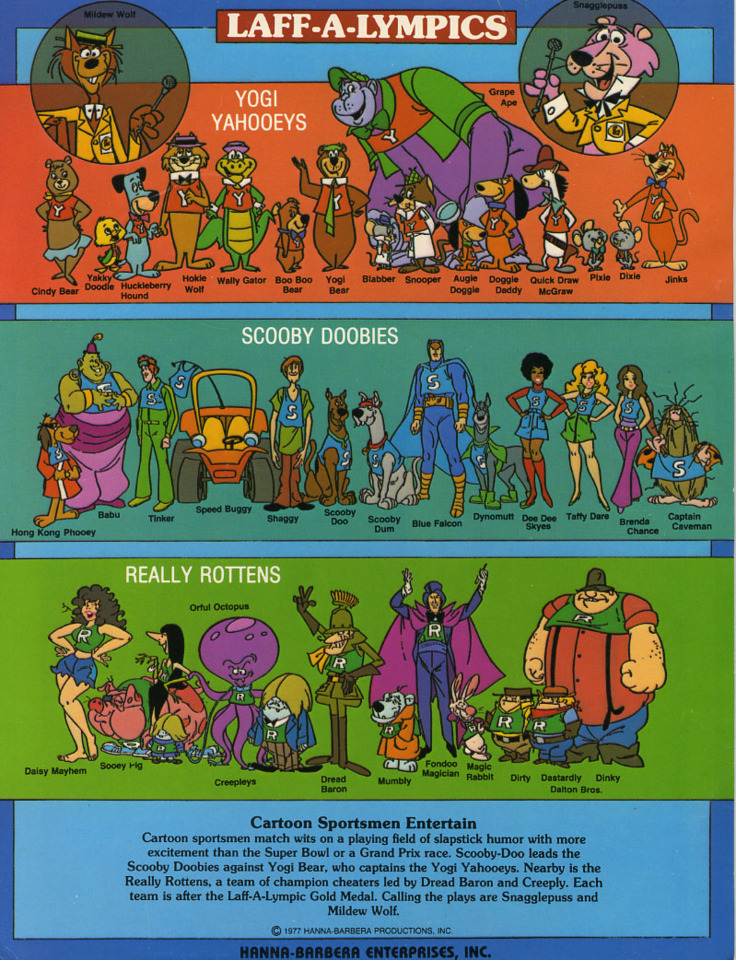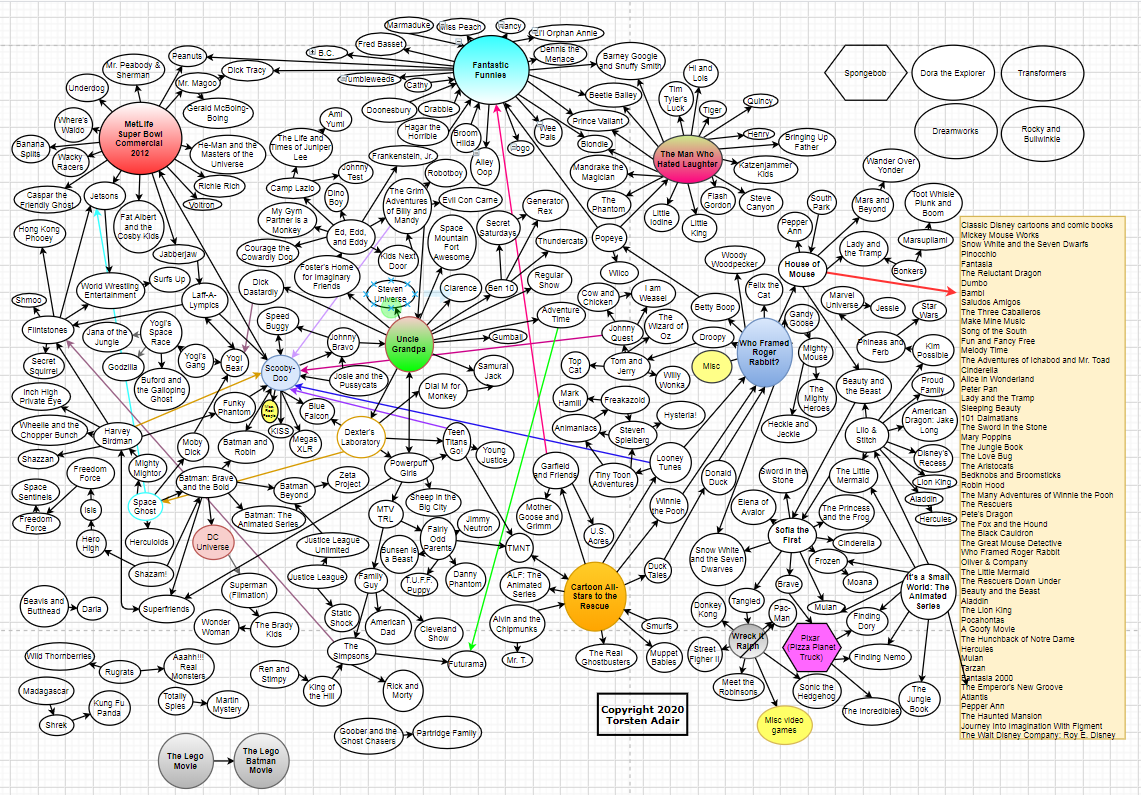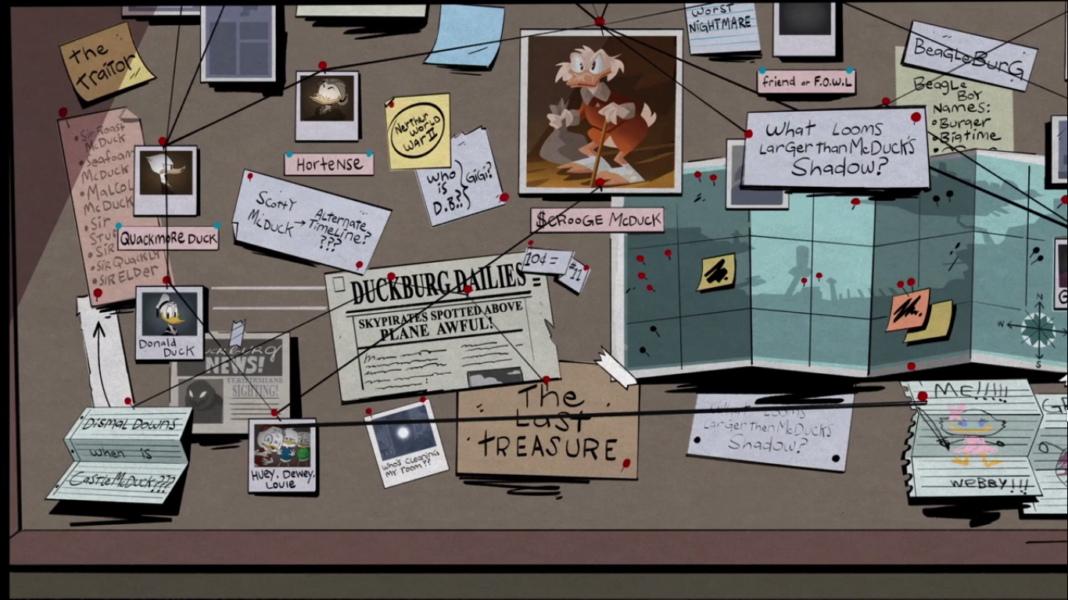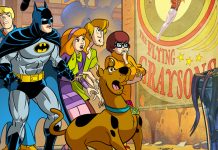Scooby-Doo recently celebrated his 50th anniversary of unmasking middle-aged real estate developers. To celebrate, I’m posting a little project I’ve been working on for a few years. I call it the Scooby-Dooniverse.
Scooby-Doo has had numerous iterations over the years (and many knock-offs, many from Hanna-Barbera[1][2]). It’s been a popular show, with a simple formula and numerous catchphrases and tropes. However, it has one aspect that is often overlooked: Scooby-Doo made the cartoon crossover commonplace. There are numerous instances of cartoon crossovers before Scooby-Doo, but those are either in-universe (such as the many cartoon characters appearing on The Wonderful World of Disney), or in propaganda films, such as this gem from Vichy France!
Yes, that’s Popeye, Mickey, Donald, Goofy, and Felix, “liberating” France!
Birth of the Scooby-Dooniverse
In 1972, CBS premiered The New Scooby-Doo Movies. Each hour-long episode had The Gang team-up with celebrities (such as Phyllis Diller and Don Knotts) or other animated characters (such as Batman & Robin and the Addams Family). Twenty-four episodes were produced, and have re-run in syndication almost perpetually since 1980. (Scooby-Doo and Guess Who? continues the tradition.)

- The Yogi Yahooies were comprised of H-B’s prime time animal characters from the 1950s and 60s, such as Yogi Bear, Huckleberry Hound, and Wally Gator [3].
- The Scoobie-Doobies featured mostly humanoid characters from H-B’s 1970s Saturday Morning roster.
- Adding necessary conflict, the Really Rottens were composed of mostly new villains inspired by previous series.
This series was popular, lasting two seasons and producing 24 episodes. Besides the 42 contestants and commentary from Snagglepuss and Mildew Wolf, there were also guest appearances from Fred Flintstone, Barney Rubble, Jabberjaw, Top Cat, Moby-Dick (!), and Magilla Gorilla.
As a child of the ’70s, I’d catch glimpses of “peripheral history”…stuff that existed a few years before (like Yogi’s Gang or the Banana Splits) but which couldn’t be researched easily because everything was so ephemeral, I was too young to know about library research, and everything was NOW. You either watched something, or you hoped it appeared later in reruns. Maybe you’d see an ad in TV Guide about a special and know to watch it. Others would remain undiscovered until the Internet encouraged light-years of virtual red yarn connecting everything in existence.
I didn’t think much about this, except for a purely trivial, geeky interest in animation. I simply enjoyed the various cameos and crossovers, and filed it away for future reference, i.e. chatting with my friends while waiting for my song to come up at karaoke.
The Tommy Westphall Universe
That changed when I discovered that comics genius Dwayne McDuffie had postulated that the final scene of the final episode of St. Elsewhere connected almost all of American television via cameos and crossovers. It’s a reduction to absurdity via continuity that, like much posted on the Internet, takes on a strange reality. You can delve deep into the Tommy Westphall Universe, as it is known, by visiting: https://thetommywestphall.wordpress.com/
There’s a nice chart that shows linkages. 441 shows, starting with I Love Lucy and continuing to the present. St. Elsewhere and Homicide: Life on the Street are the crossroads, but it even boldly goes and connects to Star Trek. (Probably via Webster.)
“Why not do that for cartoons?” I thought. My random-access memory started recalling connections. I found an open-source flowchart so I could keep it on my computer instead of on my apartment wall, and then I began to dive deep into Google.
This was 2017. It’s now 2020, and I’m still searching for links to some major cartoons, like SpongeBob SquarePants, Star Trek, and most of anime.
For this introductory post, I’ll keep it simple. (Later posts will discuss specific franchises and nexuses within the Scooby-Dooniverse.) If you want to see the chart, scroll down. If you want to follow the method of my madness, I use #CartoonCrossovers on Facebook.
My criteria is similar to Six Degrees of Kevin Bacon: if the two characters have appeared in the same production, it counts as a crossover. Even better is where they share a scene, because then you can share a crazy screenshot of, say, Scooby-Doo and KISS. Fan-fiction and fan-art do not count, nor does anything outside animation. (If you want to do this with comics, Brian Cronin played this game over on CBR.) Of course, in-universe mentions do count, such as Dr. Benton Quest creating Dynomutt.
One stumbling block I have are characters from various versions. Is the Donald Duck who appears in Who Framed Roger Rabbit? the same Donald who appears in DuckTales (1987)? Perhaps those linkages will get a dotted line, especially where DC Comics animation is concerned. I’ll probably rework the chart below by series, with sidebar boxes listing the characters, plus an appendix for real people (like Wilt Chamberlin) who guest-starred in a single episode.
The Hanna-Barbera/Looney Tunes/Walt Disney Connection
The major spine of the Scooby-Dooniverse is the Hanna-Barbera/Looney Tunes/Walt Disney connection. Hanna-Barbera includes MGM shorts, Prime Time and Saturday Morning shows, and Cartoon Network. Looney Tunes (and Merrie Melodies) includes all of the Warner Brothers cartoon characters, most of them seen in Space Jam. Walt Disney contains their “classic” characters (Mickey, Donald, Goofy), as well as their cinematic features, Pixar, and Disney television (and, yes, Marvel!).
You create that spine by linking Scooby-Doo (and Shaggy) to Bugs Bunny…
…and then Bugs to Mickey Mouse.
Scooby-Doo cameos with almost every Warner Brothers property (Cartoon Network, Looney Tunes, Hanna-Barbera, DC Entertainment). Bugs is not as popular, or maybe his star status allows him to pick with whom he wishes to work. Once you link to Mickey Mouse, House of Mouse connects to almost every Disney animated feature and cartoon (yes, even including their current offerings on cable).
Here’s a quick list of cartoon crossover series, specials, and movies I’ve used to create the crazy cat’s cradle of connections shown in my chart below.
- Popeye Meets the Man Who Hated Laughter
- The Fantastic Funnies
- Who Framed Roger Rabbit
- MetLife “Everyone” Super Bowl XLVI ad
- Cartoon All-Stars to the Rescue
- “The Grampies” (Uncle Grandpa)
- House of Mouse
- Cartoon Network’s 20th anniversary bumpers and the CN City branding.
- Wreck It Ralph
- Harvey Birdman, Attorney at Law
- OK K.O.! Let’s Be Heroes

(Or click here for a full-size version.)
Are there any I missed? Add your favorites below, preferably with a YouTube link! And check back for more as I break down specific areas of this massive Scooby-Dooniverse.
[1] Josie and the Pussycats, Butch Cassidy and the Sundance Kids, The Funky Phantom, Speed Buggy, Clue Club, and Jabberjaw, to name a few…
[2] https://twitter.com/jongraywb/status/1122561397727035395
“A complete (?) listing of every Hanna-Barbera/Ruby-Spears Scooby-Doo clone: a thread”
[3] Yogi’s Gang aired in the Fall of 1972, having spun off from a made-for-tv movie. It’s pedantry guaranteed it only lasted three months. It’s noted in teaming-up 20 various Hanna-Barbera characters into one show. Sadly, none of these characters ever regained their popularity from prime time.








Fun idea.
Harvey Birdman, Attorney At Law was a great showcase for members (particularly minor members) of the Scooby-Dooniverse. The writers would throw minor Hanna-Barbera characters into the spectator area of the courtroom willy-nilly.
I just discovered that Wacky Races (1968) predates Laff-A-Lympics by a decade with numerous H-B cameos.
I wasn’t born then, so it never appeared on my (speed) radar until now.
Scooby-Doo is ubiquitous, has cameos in almost every series (including the upcoming “Scoob” movie), and the name is “doo” perfect, so it remains.
That said, both Scooby and Dick Dastardly are important bridges from classic Hanna-Barbera television shows to Cartoon Network series.
You’re bonkers, keep it up!
Bonkers is on the list. It links to Lady and the Tramp and Marsupilami!
Comments are closed.